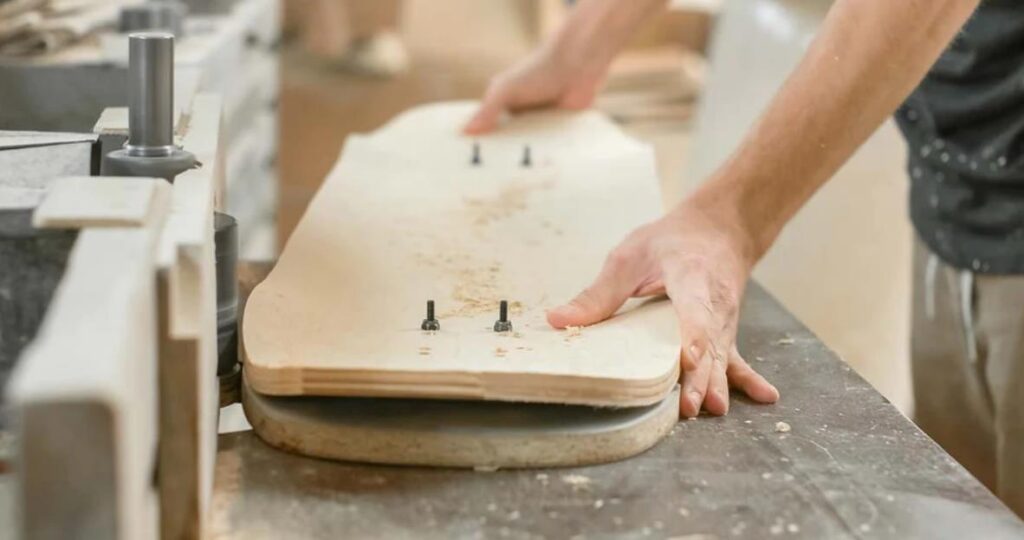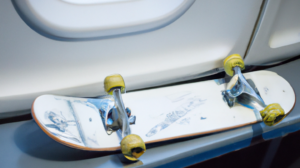Skateboarding is a thrilling and dynamic sport that demands precision, technique, and balance. But have you ever wondered what factors determine the flexibility and durability of a skateboard deck? Whether you’re a newbie or a seasoned skateboarder, understanding these factors opens up possibilities for customization and finding the perfect board that suits your style and needs.


In this blog post, we’ll delve deep into skateboard deck construction, exploring the materials, shapes, and techniques contributing to its flexibility and durability. So, grab your helmet and knee pads, and let’s roll!
The Magic Lies in the Layers
We must first familiarize ourselves with the construction process to understand the factors influencing skateboard deck flexibility and durability. Skateboard decks typically comprise several layers of wood veneers, thin slices of wood glued together with epoxy resin. These veneers are stacked on top of each other, typically in odd numbers, and each one is oriented in alternating directions.
This unique construction method creates a strong, lightweight, flexible, and sturdy deck. The number of veneer layers and the type of wood used significantly impact the board’s performance. Let’s delve into each of these factors to gain a better understanding:
Number of Veneer Layers – Finding the Right Balance
The number of veneer layers in a skateboard deck determines its flexibility and durability. Typically, skateboard decks comprise 7 to 9 veneer layers, but this can vary depending on the desired characteristics.
Fewer layers create a more flexible deck that is easier to maneuver and provides a lively pop. This flexibility allows skateboarders to perform tricks and maneuvers that require bending and flexing the deck, such as ollies or kickflips. Professionals and street skateboarders often prefer decks with fewer layers for increased maneuverability.
On the other hand, more layers make the deck stiffer and more durable. Many veneer layers enhance the board’s strength, making it suitable for ramps, bowls, and higher-impact skating. Skaters prioritizing stability, control, and resistance to breakage often choose decks with more layers.
Type of Wood – Strength and Aesthetics
The type of wood used in skateboard decks significantly affects their overall performance. Skateboard decks are commonly made from maple, offering an ideal combination of strength and flexibility. Maple wood is incredibly durable, providing a strong and long-lasting deck that can withstand the harsh impact and stresses of skateboarding.
Other types of wood, such as bamboo or birch, are occasionally used to achieve different characteristics. Bamboo, lighter and more flexible than maple, lends itself well to downhill cruising and carving. Birch, known for its stiffness, is preferred by skaters who prioritizing stability and control.
The quality and grade of the wood used can also influence the flexibility and durability of the deck. Higher-grade wood tends to have fewer knots and imperfections, resulting in a more robust and consistent deck. So, consider the wood type and quality when selecting your skateboard deck!
Shape and Concave – The Secret Sauce
While the number of veneer layers and the type of wood lay the foundation for a skateboard deck’s performance, the board’s shape and concave are like the secret sauce that enhances the overall riding experience. Let’s take a closer look at these factors:
Shape – Style and Purpose
Skateboard decks come in various shapes, each serving a different purpose or style of skating. The two most common shapes are the popsicle and the cruiser shape.
Popsicle-shaped decks have a symmetrical design with a slightly pointed nose and tail, making them ideal for street and park skateboarding. Their versatile shape allows skaters to perform tricks from any direction and provides a balanced feel underfoot.
Cruiser-shaped or “old school” decks have a more pronounced nose and tail with a broader and rounded shape. These decks are perfect for cruising, carving, and downhill riding due to their stability and larger surface area.
The shape of the skateboard deck affects its maneuverability, stability, and control, so choose a form that aligns with your style and skating preferences.
Concave – Locking in Your Feet
If you’ve ever stood on a skateboard, you may have noticed the slight curvature of the deck. This curvature is called concave and plays a vital role in providing control and grip for skateboarders.
Several types of concave profiles exist, including low, medium, and high. Soft concave offers a mellow curve, providing a more relaxed and comfortable feel underfoot. Medium concave is the most common, often found in popsicle-shaped decks, and provides a good balance between control and comfort. High concave decks have a steeper curvature, ensuring maximum grip and control, making them popular among professional and technical skaters.
The choice of concave largely depends on personal preference and the skating you plan to do. Experimenting with different concave profiles can help you find the sweet spot that enhances your riding style and comfort.
Taking Care of Your Skateboard Deck
Now that we’ve explored the essential factors that determine the flexibility and durability of a skateboard deck, it’s vital to understand how to maintain its performance and longevity. Here are a few tips for taking care of your skateboard deck:
- Avoid excessive exposure to water and moisture, as it can cause the wood to warp or weaken.
- Regularly inspect your deck for wear or damage, such as cracks, delamination, or splintering. Replace the deck if necessary.
- Keep your skateboard away from extreme temperatures to prevent warping or shrinking.
- Use grip tape to protect the deck’s top surface and enhance your grip while skating.
- Consider using skateboarding shoes with softer soles, as they reduce the impact on the deck and help maintain its flexibility.
By following these simple maintenance procedures, you can extend the life of your skateboard deck and ensure optimal performance throughout your skating trip.
In Conclusion
Understanding the factors determining a skateboard deck’s flexibility and durability empowers you to make informed decisions when selecting or customizing your board. Remember, the number of veneer layers, the type of wood, and the deck’s shape and concave all contribute to your riding experience.
Whether you’re a beginner finding your footing or an experienced skater looking for the perfect deck that meets your needs, consider these factors when choosing. And most importantly, enjoy the ride and embrace the freedom and creativity that skateboarding brings!
Note: The information provided in this blog post is for educational purposes only. Ensure you consult with professionals and reliable sources before deciding on skateboarding equipment.







